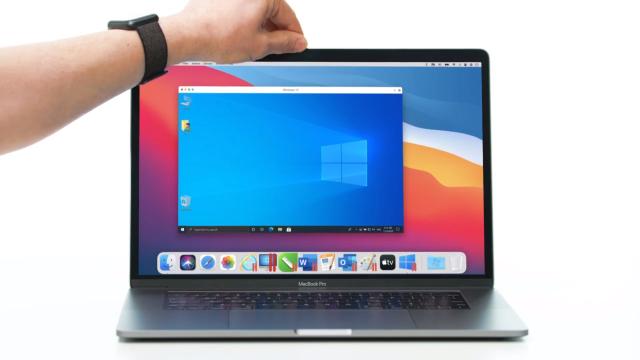Anyone looking for a way to run Windows 10 on a new Mac with Apple Silicon now has an easy, reliable option. Parallels just released a new version of its virtual desktop tool, Desktop 16.5, that supports Windows 10 on M1 Macs.
Parellels brought over many of the popular features from its previous Intel-based version of Desktop, including Coherence Mode, which lets users run Windows applications as if they were native to the Mac without switching between desktops or rebooting their entire system. Users can also easily share files locally to the Windows 10 virtual machine, customise MacBook touch bar controls to launch Windows apps, and do a bunch of other things that were included with Desktop 16.
Parallels claims running a Windows 10 on its virtual machine on an M1 Mac nets up to a 30% increase in performance over a Windows 10 virtual machine running on a MacBook Pro with a high-end Intel processor. It also claims users will see up to a 60% performance increase with DirectX 11 applications compared to an Intel-based MacBook Pro with a Radeon Pro 555X GPU.
However, there’s a catch. Parallels Desktop 16.5 only supports ARM-based operating systems. There is an ARM version of Windows 10, but it’s only available for those who are enrolled in the Windows Insider program. Anyone can enroll in the program, but Windows 10 for ARM is still a preview version, and there’s a good chance you’ll run into bugs or glitches.
That doesn’t mean you’ll have a bad experience running Windows 10 for ARM on an M1-powered Mac, but performance could take a dip if you wanted to run native x86 programs made to run on Intel and AMD chips with the emulator that comes with Windows 10 for ARM. Performance is limited to the specs inside whatever computer is running the virtual machine anyway, but emulation on a virtual machine is a whole other layer.
Depending on the program, you might be better off running an x86 macOS application via Apple’s own emulation software, Rosetta 2, without a virtual machine. Software compatibility for M1 Macs is slowly getting better, but for some it’s the biggest hurdle to upgrading to an Apple Silicon machine.
If you already have a Parallels Desktop 16 for Mac licence, you can upgrade to 16.5 for free, and will continue to receive updates for free as new versions are released. Those on Parallels Desktop 14 or 15 will have to pay about $65 to upgrade. A new Parallels Desktop 16.5 licence starts at $105 for a perpetual licence or $130 a year for a subscription.
Additionally, Parallels Desktop 16.5 supports a few popular ARM-based Linux distributions: Ubuntu 20.04, Kali Linux 2021.1, Debian 10.7, and Fedora Workstation 33-1.2. Parallels is also working on a virtual machine version of macOS Big Sur that it hopes to release later this year.
